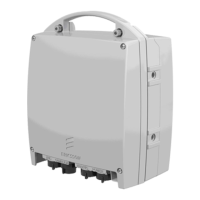MINI-LINK BAS 4-2
Technical Description EN/LZB 111 0542 P2B
4.1 Introduction
Small and medium sized offices require support for data and
telephony traffic interconnection. Data traffic can be either between
the end-user LANs or between a LAN and the Internet.
In a similar way the telephony traffic can be either between end-user
PBXs or between a PBX and the PSTN.
These different interconnection cases are shown in Figure 4-1.
PBX
LAN
Router
PBX
Router
Internet
LAN
MINI-LINK BAS
PSTN
ATM
LAN
PABX
LAN
Leased Digital
(E1/T1)
Leased Lines
Figure 4-1 Different Traffic Interconnections Needs
Traditionally the services described above have been offered to the
end-users as leased lines based on the telephony network
infrastructure with a permanently allocated capacity and a granularity
of 64 Kbps.
MINI-LINK BAS offers both permanent capacity allocation for PBX
interconnectivity and the possibility to offer better performances for
data traffic exploiting statistical multiplexing and bandwidth
allocation not constrained by the 64 Kbps granularity. Statistical
multiplexing at the air interface is obtained via the F-DCA feature
offered by the MAC at the air interface, see Chapter 5.
10/100 Base-T Ethernet interfaces at the NU, named FlexNU, are
offered for data communication. E1 and T1 interfaces are available for
PBX interconnectivity. Up to 4 SUs can be installed in a FlexNU.
Each FlexNU offers 2 interfaces. In addition, a 10 Base-T Ethernet
interface is available in the FlexNU mainly for OAM purposes, but
can also be used for support of pure best effort data traffic.

